Every year, car accidents injure or kill thousands of children across the United States. Proper car seats and restraints can dramatically reduce these tragedies. According to the Centers for Disease Control and Prevention, motor vehicle crashes in 2022 claimed the lives of 599 child passengers aged 12 and younger and injured more than 106,000 others in the U.S.
So, using car seats reduces the risk of injury for children by 71-82% compared with seat belt use alone. However, navigating the maze of car seat laws can be challenging for parents and caregivers, as requirements vary significantly from state to state.
Understanding what is child passenger safety?

Before diving into state-specific requirements, it’s helpful to understand the different types of child safety restraints:
- Rear-facing car seats: Designed for infants and small children, these provide the best protection for a child’s developing neck and spine.
- Forward-facing car seats: Used when children outgrow rear-facing seats but still need the protection of a five-point harness.
- Booster seats: Elevate children so that adult seat belts fit them properly across the shoulder and lap.
- Seat belts: Eventually, children can transition to using the vehicle’s regular seat belts.
State-by-State Requirements
Alabama
Alabama requires children under 6 years of age to use appropriate child restraint systems. Children must use a rear-facing seat until at least 1 year of age or 20 pounds, while those 6 until 15 years must use seat belts.
Alaska
In Alaska, children under 4 years must use a child safety seat, while children between 4 and 8 years who are less than 65 pounds or less than 57 inches tall must use a booster seat. Seat belts are required for children 8 years and older.
Arizona
Arizona law mandates car seats for children under 5 years, and booster seats for children aged 5 until 8 years who are under 4’9″ tall. Children 8 years and older must wear seat belts.
California
California has some of the strictest requirements. Children under 2 years who weigh less than 40 pounds or are under 40 inches tall must be in rear-facing car seats. Children under 8 years or under 4’9″ tall must be in appropriate child restraint systems, with those under 8 years required to be in the back seat when possible.
Colorado
In Colorado, children under 1 year and under 20 pounds must be in rear-facing car seats. Children 1 to 4 years and 20-40 pounds must use forward-facing car seats. Children aged 4 through 7 years and under 55 inches must use booster seats, while seat belts are required for children 8 years and older.
Similar patterns continue across other states, with variations in age, weight, and height requirements. For example, some states focus primarily on age (like South Dakota, which requires restraints for children under 5), while others incorporate more specific height and weight considerations (like Rhode Island, which has requirements based on both age and size measurements).
Enforcement Variations
States also differ in how they enforce these laws. Some states have “primary enforcement,” meaning officers can stop and ticket drivers solely for child restraint violations. Others have “secondary enforcement,” where tickets can only be issued if the driver is stopped for another violation first.
According to the document provided, states like Alabama, California, and Delaware have primary enforcement, while states like Idaho and Colorado have secondary enforcement for certain provisions. This affects how strictly these laws are enforced from state to state.
What are the best practices for child passenger safety?
While legal requirements provide a baseline, safety experts often recommend more stringent practices than what states require. The American Academy of Pediatrics recommends:
- Using rear-facing seats for as long as possible, often well beyond age 2
- Using forward-facing seats with harnesses until children reach the maximum height or weight allowed by the manufacturer
- Using booster seats until adult seat belts fit properly (typically when a child reaches 4’9″ tall)
- Keeping children in the back seat until at least age 13
Think of car seats like bicycle helmets. The law may only require them in certain situations, but using them more extensively provides better protection. Just as you wouldn’t let your child ride a bike without a helmet just because they turned a certain age, safety should be the priority when it comes to car seats, not just meeting minimum legal requirements.
Special Considerations for Travelers
If you’re traveling between states with children, it’s wise to follow the most stringent requirements of any state you’ll be visiting. This is similar to how drivers typically adjust to the most cautious speed limits when crossing state lines. When in doubt, err on the side of caution and use appropriate restraints based on your child’s size rather than just their age.
Evolution of Car Seat Laws
Car seat laws have evolved significantly over time. Massachusetts enacted the first child passenger safety law in 1973, but it wasn’t until 1985 that all 50 states had such laws. These laws continue to evolve as research provides new insights into child safety.
For example, in states like California [1], there is a relatively recent requirement for rear-facing seats until age 2. Reflects newer research showing the significant safety advantages of this position for young children. As our understanding of child safety improves, we can expect further updates to these requirements.
Conclusion
Navigating child car seat requirements across different states can be complex, but understanding these laws is crucial for keeping children safe. When in doubt, follow the more stringent guidelines from safety organizations rather than just meeting the minimum legal requirements. After all, the goal isn’t just to avoid a ticket, it’s to protect our most precious passengers.
Remember that car seats should be properly installed to be effective. Many local police stations, fire departments, and hospitals offer free car seat installation. Check to ensure your child’s seat is correctly installed. Taking advantage of these resources can provide additional peace of mind beyond simply following the letter of the law.



